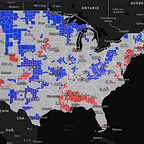US COVID Cases At An All-Time High: Midwest Hotspots Continue to Grow
By Kenna Camper, Laura Chen, Dylan Halpern, and Marynia Kolak
From November 6 to November 13, the number of COVID-19 cases in the United States reached an all-time high of 170,000 daily cases. More specifically, hotspots in Midwestern states, like the Dakotas, Iowa, Illinois, Minnesota, and Wisconsin continue to grow, with rural communities especially impacted.
Highlights from this week include:
- The Dakotas, Iowa, Illinois, Minnesota, and Wisconsin are seeing increasing hotspots throughout this past week. While previously an anomaly among the Midwest, Minnesota has shown exponential growth in new cases, with hot spots expanding throughout most of the state.
- As Illinois has reached over 585,000 total cases and Cook County’s numbers have increased to over 246,000 known cases, Chicago has enacted a Stay-at-Home Advisory. The guidelines urge residents to stay at home as much as possible, limit gatherings to 10 people or less, and wear masks.
- Recently areas around the border between Michigan, Indiana, and Ohio have become places of emerging risk. Indiana may soon be increasingly affected through the spread from hot spot clusters in nearby Illinois counties.
- Spillover to Minnesota and Iowa possibly because of the Dakota states, though more details and contact tracing would be required to confirm.
- Stutsman County in North Dakota has stayed a stable hotspot. From November 6 to November 13, the region saw 509 more cases, with the total confirmed cases reaching 1928.
In anticipation of this upcoming Holiday season, especially Thanksgiving, the CDC recommends considering holiday plan modifications to “reduce the spread of COVID-19 to keep your friends, families, and communities healthy and safe.”
Such suggestions include the following:
- Be cautious of traveling.
- “Thanksgiving is a time when many families travel long distances to celebrate together. Travel increases the chance of getting and spreading the virus that causes COVID-19. Staying home is the best way to protect yourself and others. If you must travel, be informed of the risks involved.”
- Consider having Holiday gatherings outdoors:
- “Host outdoor rather than indoor gatherings as much as possible. Even outdoors, require guests to wear masks when not eating or drinking.”
- Be conscious of those who have or have been exposed to COVID-19:
- “Do not host or attend gatherings with anyone who has COVID-19 or has been exposed to someone with COVID-19 in the last 14 days.”
Explore the US Covid Atlas on your own: https://theuscovidatlas.org/map.html
